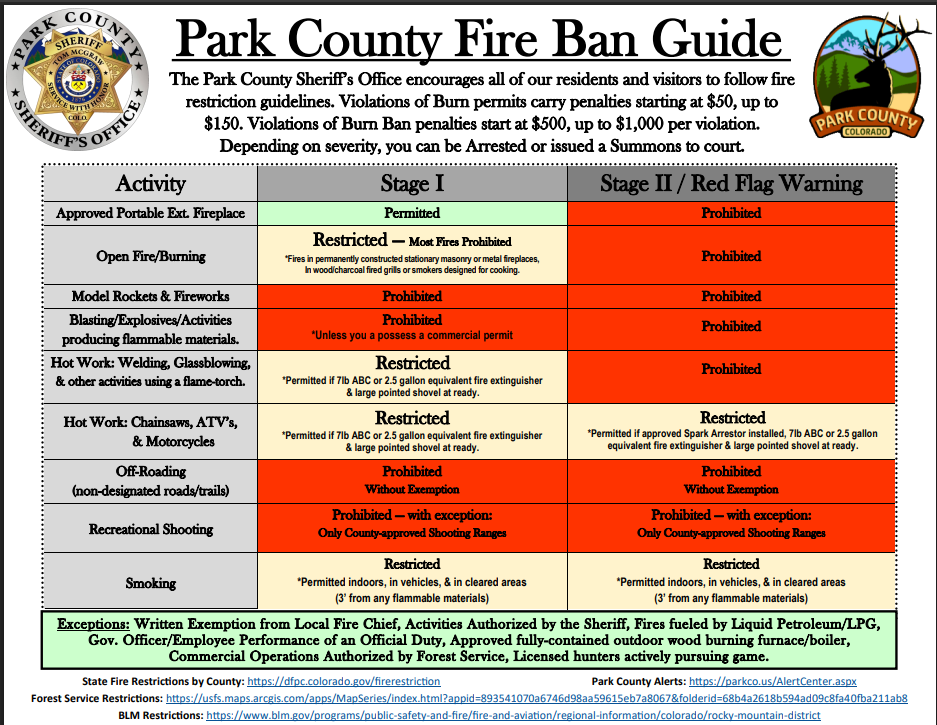Wildfire
Wildfire Readiness and Information
Start living wildfire ready with these simple, practical, low-cost actions.
- Regularly clear leaves, pine needles and other debris from your deck, roof and gutters.
- Rake and remove pine needles and leaves 5 feet from your home.
- Store firewood at least 30 feet from your home, preferably uphill, and never on or under your deck.
- Move items under your deck or porch to a storage area.
- Prune branches hanging over your roof and within 10 feet of your chimney.
- Remove flammable material within 6 vertical inches of your home’s siding.
- Mow grasses to 4 inches or less within 30 feet of your home.
- Clear brush, shrubs and other plants within 10 feet of propane tanks and gas meters.
- Screen attic, roof, eaves and foundation vents and wall-in areas below decks and stilt foundations with 1/8-inch metal mesh.
Wildfires are a natural part of Colorado’s forests.
If you live in the wildland-urban interface in Colorado, where homes and other structures intermingle with wildland vegetation, you are at risk of being affected by wildfire. Planning ahead and taking action can increase the likelihood your home survives when a wildfire occurs.
Click here to learn more about protecting your home and property at the Colorado State Forest Service Website (External Link)
Please visit Colorado's new Live Wildfire Ready website for resources and information.
RED FLAG WARNING- (definition per (NWS) National Weather Service- (NWS) issues Red Flag Warnings & Fire Weather Watches to alert land management agencies about the onset, or possible onset, of critical weather and fuel moisture conditions that could lead to rapid or dramatic increases in wildfire activity. This could be due to low relative humidity, strong winds, dry fuels, or any combination thereof.
Fire weather zones are areas that are susceptible to fire potential and growth and thus different aspects of the environment must be monitored to predict fire potential. Hartsel is in Fire Zone 214. You can read the daily forecast here: Fire Zone 214.
RED FLAG-BURN BAN MESSAGE:
As we descend into the dog days of summer it becomes commonplace to see the various fire districts in Park County opt to enter into a burn ban. These bans can last for a specific amount of time on one day or can cover several weeks.
To the average citizen, the county wide approach may seem whimsical, but rest assured that the decision to enter into or not enter into a burn ban comes with much deliberation and is a thoughtful decision. Hopefully after reading this piece we can help allay some of the confusion that surrounds this nebulous bit of regulation.
The first critical element to understand is the red flag warning and subsequent county wide burn ban that is instituted when a red flag event is present. Park County sits in fire weather zones 212, 214, and 216. If at any point any of those zones show red flag weather is forecast for the day it triggers a county wide burn ban. This broad stroke approach was born from the need to have a streamlined system when going into a burn ban. It became too difficult for both dispatch and the Sheriff’s department to manage and enforce the laws in regards to burn bans when every district in the county was on its own page. We are aware that this approach has not always been the most popular with some residents. One reason for this frustration seems to be that this method can push a burn ban in an area that might not be experiencing the critical fire weather that neighboring areas are under threat from. Admittedly, an inconvenience.
The factors that a fire chief considers when opting to enter into a single district non-red flag burn ban rests with a few specific considerations. The first such consideration is given to fuel moistures, both live and dead. There are critical thresholds the fuels can reach, in regards to how dry they are, that make them much more receptive to carrying fire. As each district tests the moisture levels of the fuels in their area and once these critical moisture thresholds have been recorded then the communities will start to see individual fire districts enter into their own bans. Other factors that can push fire districts into a burn ban are relative humidity, hot temperatures, and high winds for extended periods of time.
We at the various fire districts of Park County enjoy the same freedoms and benefits to living in such a wonderful place as those of you reading this piece. Your local district’s goal is never to hinder someone's “good time” or regulate in a way that alienates the fire districts from our wonderful communities. The burn ban option is one that is never taken lightly. Campfires and cookouts are arguably some of the finest elements that the summers in the Rockies have to offer. Due to these considerations, and many others, the decision to go into a burn ban is driven by empirical observations and real observed data. Opinion is removed from this decision by all agency chiefs in an attempt to implement this critical, yet sometimes inconvenient bit of regulation when necessary.
Thank you for taking the time to better understand the regulations in your area and learn something about the fire environment that we have all chosen to settle in.

